
FAQ
Serving Families Throughout Ellensburg-
Types of Wildlife
-
California Gray Squirrels
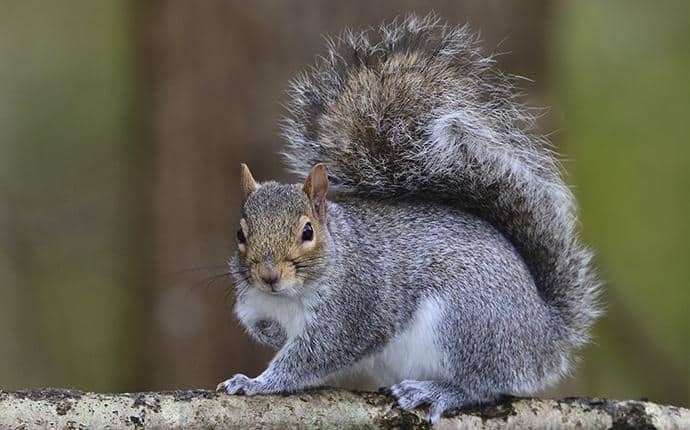
Large ground squirrels, California gray squirrels are members of the rodent family and are grayish-brown in color with off-white coloring on their bellies. They also have a triangular patch of dark fur on their backs. Their tails may be bushy but aren’t always. They grow up to 11 inches in length and their tail adds another seven inches to their total length.
-
Chipmunks
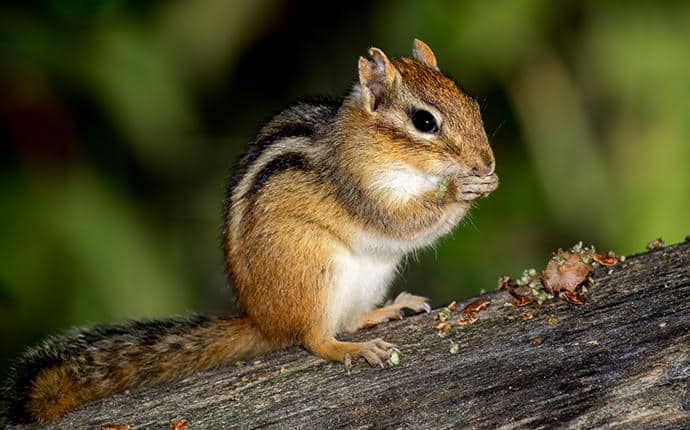
Chipmunks are also a type of rodent and have easily identifiable dark brown and light brown stripes that run down their backs; the rest of their bodies are reddish-brown in color. Their tails are about three to four inches long and are darker in color than the rest of them. Adult chipmunks grow to between five and six inches in length (not including the tail) and weigh between 2 ½ and 3 ½ ounces.
-
Douglas Squirrels
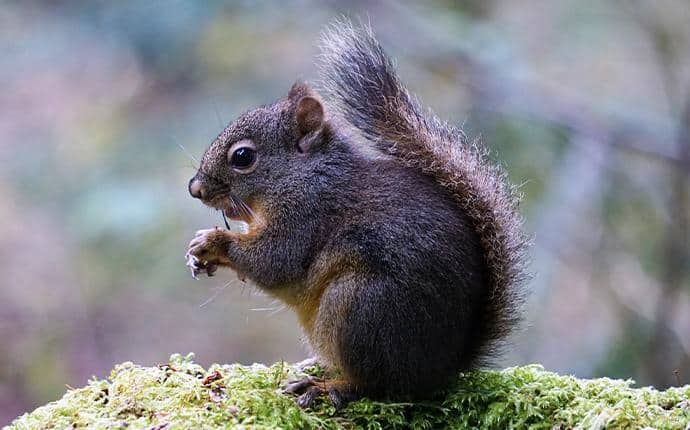
Another rodent, Douglas squirrels are small squirrels that grow to about 12 inches in length when you include their five-inch bushy tails. They have dark brown fur on their backs that fade to a reddish-gray or brownish-gray. Their tails have a black tip. These squirrels are very vocal and often heard “scolding” people.
-
Marmots
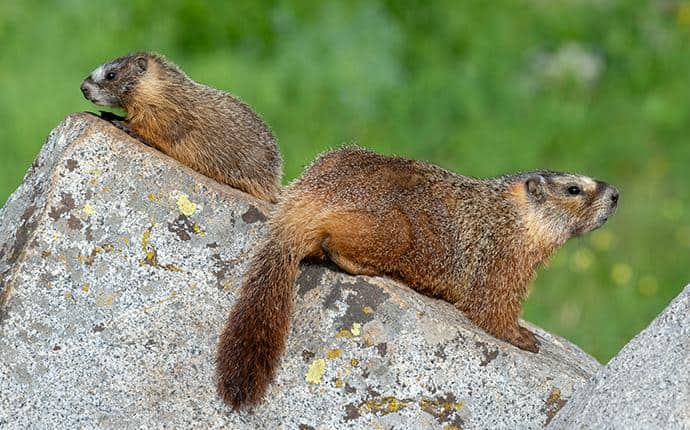
Marmots are house cat-sized rodents and may exceed 10 pounds. They appear in shades of brown, yellow, or tan and have long, bushy tails.
Marmots are capable of producing a piercing whistle. They use their whistle to warn off predators and potential intruders.
*Limited services available for marmots.
-
Raccoons
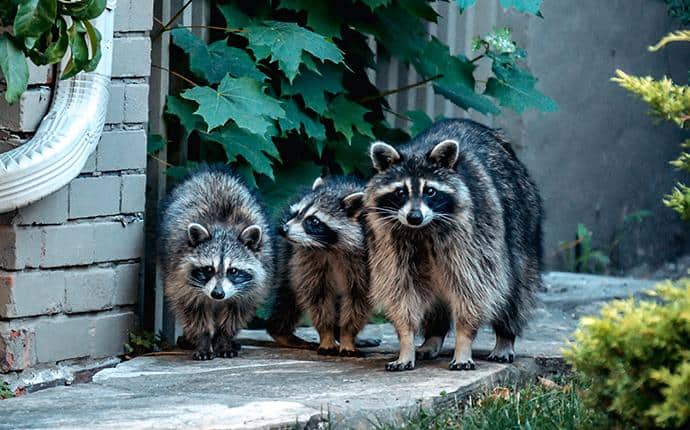
Raccoons have many easily recognizable physical features including a black “mask” of fur that surrounds their eyes, fluffy black and gray ringed tails, and a hunched appearance caused because their hind legs are longer than their front legs. Their bodies are covered in dense salt and peppered colored fur. Raccoons may grow to up to three feet in length and weigh between 10 and 30 pounds.
-
Skunks
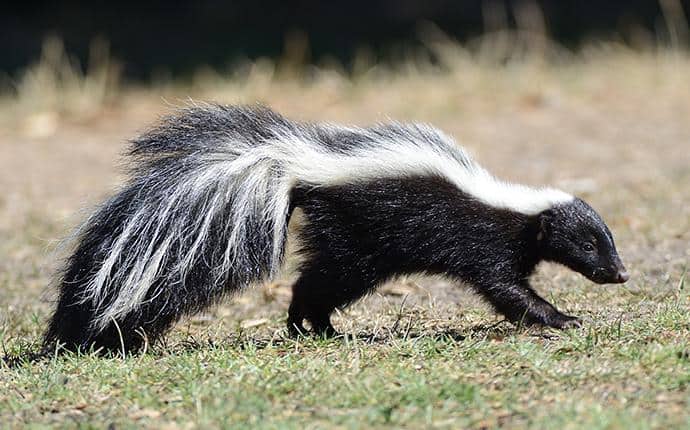
Their most unique feature is their black body which has a white stripe starting at their head and divides into two stripes that travel down their entire body and tail. But, their most identifiable characteristic is the extremely foul odor that skunks spray from glands found at the base of their tail as a defense mechanism. If sprayed directly into a person's or animal's eyes the spray can cause temporary blindness.
Adult skunks grow to between 20 and 30 inches in length, with their tail adding 7-15 inches to their total length. Adults weigh between 2.5 and 11.5 pounds (i.e. the size of a small housecat).
*Limited services available for skunks.
-
-
Types of Ticks
-
Brown Dog Ticks
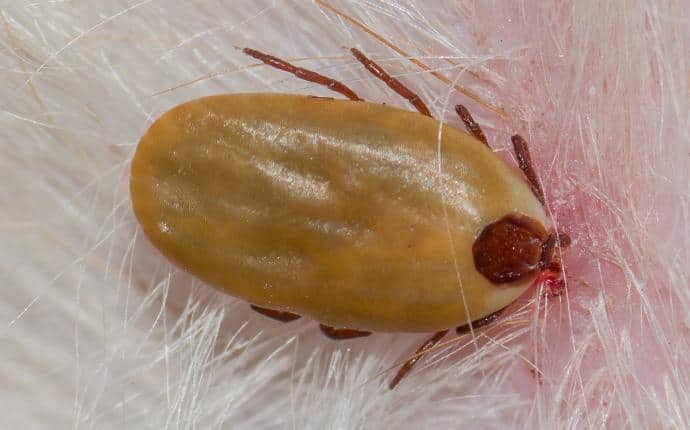
Prior to a blood meal brown dog ticks are reddish-brown in color and have no real distinctive markings; they are about 1/8th of an inch long and they have flat elongated bodies. After feeding their bodies expand to about ½ of an inch in length and they turn a steel blue-gray color.
-
Rocky Mountain Wood Ticks
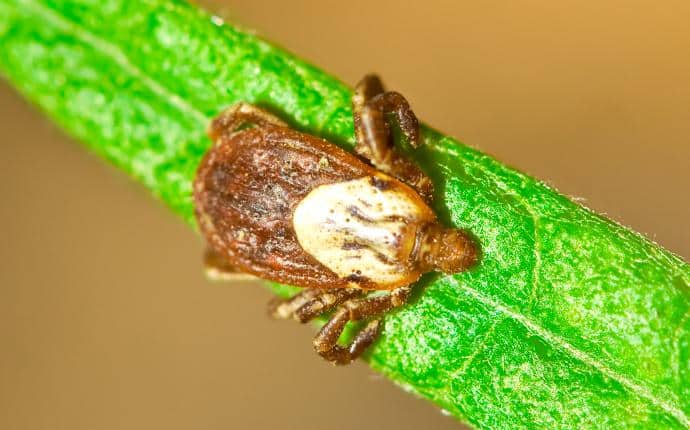
Rocky Mountain wood ticks look very similar to American dog ticks. Before feeding they are brownish in color and after feeding they turn grayish in color. They are huskier, more full-bodied and have shorter mouthparts.
-
Western Black Legged Ticks
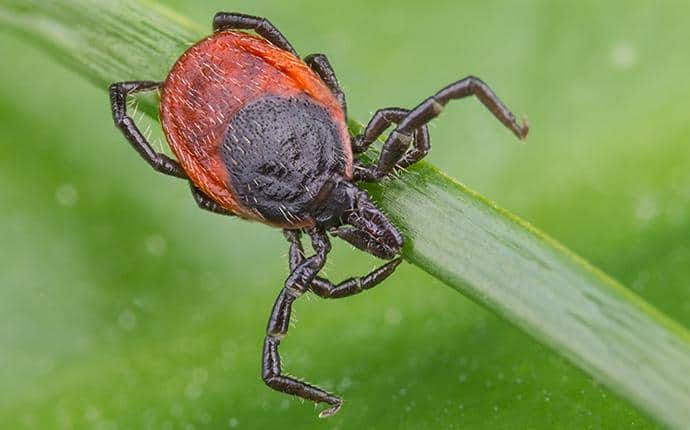
Adult black-legged ticks have a hard, oval shaped body that is brownish-black in color. Females have brown-black plates on their backs and orange colored abdomens. Their eight legs are darker in color than the rest of their bodies.
-
American Dog Ticks
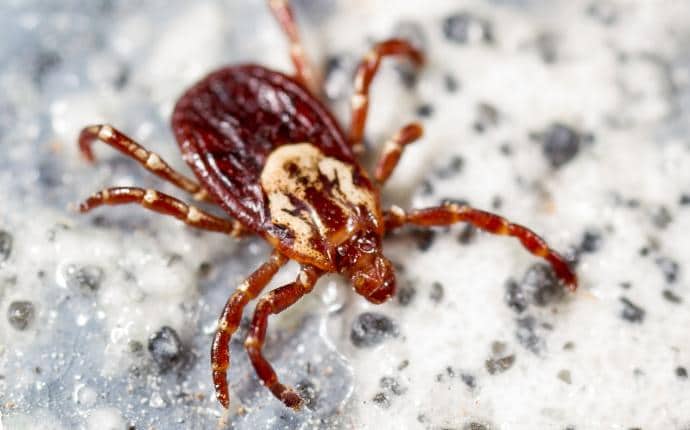
Before feeding American dog ticks are brownish-tan in color and have marbled white or yellow markings. After consuming a blood meal they turn grayish-blue or olive green in color. Their bodies are oval in shape but when full of blood they increase in size and become rounder.
-
-
Types of Termites
-
Termite Workers
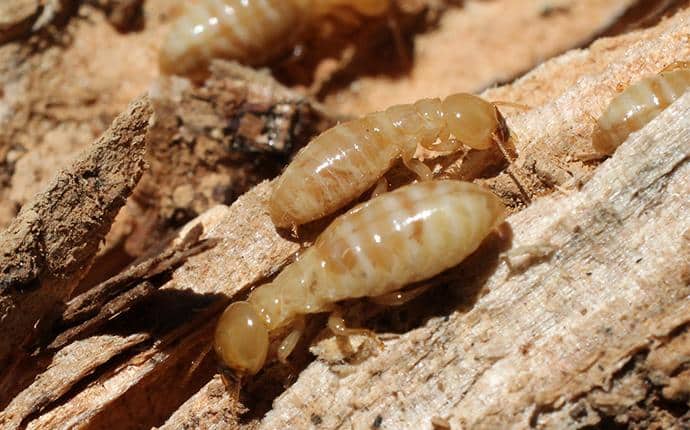
Termite workers are wingless, soft-bodied, and look very similar in size and shape to whitish or cream-colored ants. These insects make up the bulk of a termite colony and are responsible for gathering food for the rest of the colony.
-
Termite Soldiers
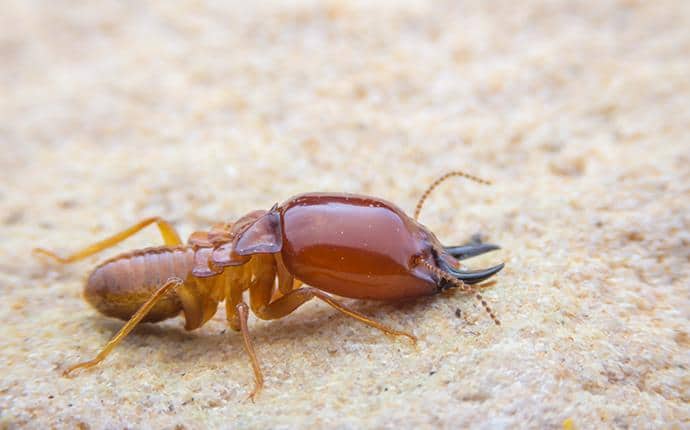
Similar in appearance to workers, termite soldiers have large rectangular heads that are orange or amber in color. They have large pincher-like mouthparts that they use to defend the colony. Interestingly, they are blind.
-
Reproductives
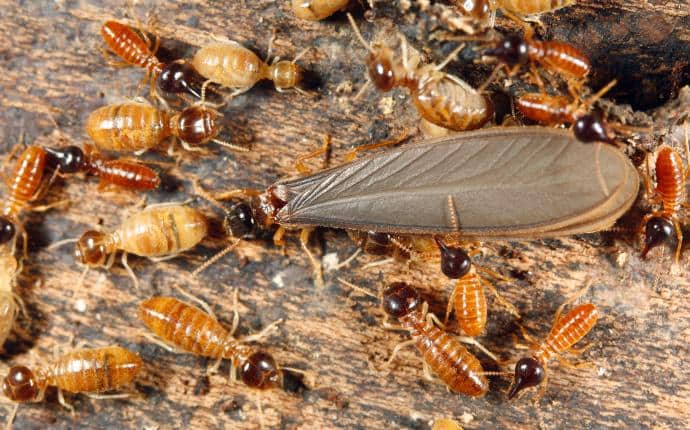
Reproductives, also known as termite swarmers, have brown bodies with light brownish-gray wings. They have two pairs of wings not equal in size; their front wings are larger than their hind ones. Reproductives will leave existing termite colonies in order to find a mate and establish a new colony.
-
-
Types of Stinging Insects
-
Bald Faced Hornets
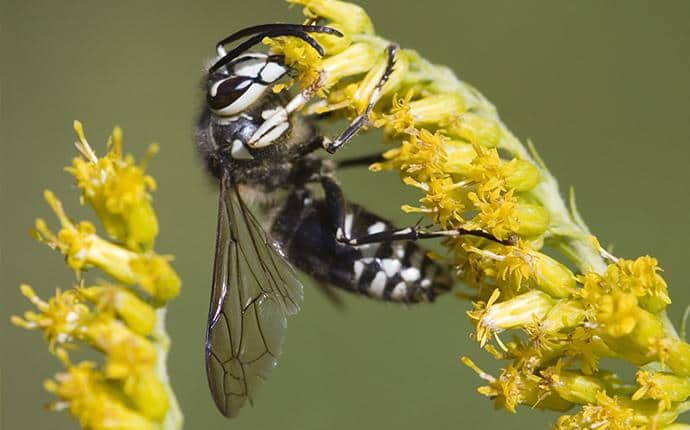
A large stinging insect, bald-faced hornets are not actually hornets. They are relatives of yellow jackets and paper wasps and have long, think wasp-like bodies. Their bodies are black and they have an off-white pattern covering most of their faces.
-
European Paper Wasps
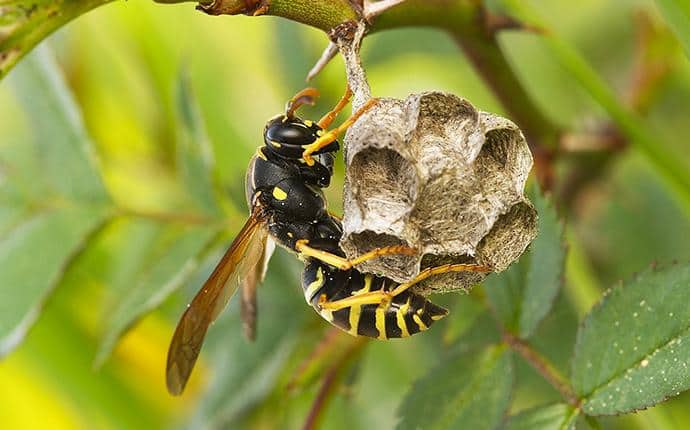
These wasps are semi-social and live together in small colonies. While they grow up to ¾ of an inch in length, paper wasps in Washington state can be distinguished from stockier yellow jackets by their slender bodies.
-
Western Yellow Jackets
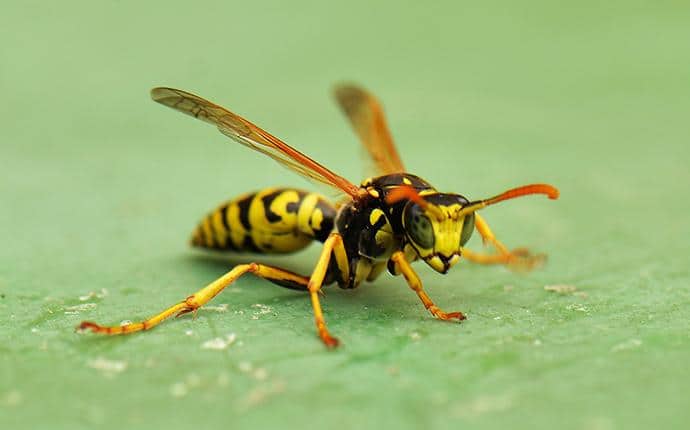
Very social insects, yellow jackets live together in large colonies with thousands of members. Workers may appear in combinations of yellow and black and white in black, they grow to about ½ inch in length.
-
-
Types of Spiders
-
Black Widow Spiders
.2403171734550.jpg)
Shiny black in color, black widows have a unique identifying red mark on the underside of their abdomens. This marking resembles an hourglass. The black widow spins disorderly appearing webs typically close to the ground. While they appear chaotic, black widow webs are carefully constructed to effectively capture prey. Learn more about black widow spiders.
-
Cellar Spiders
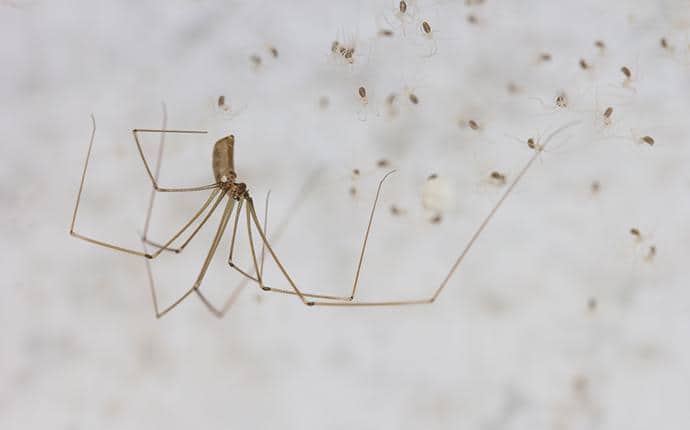
Commonly pale yellow, light brown, or grayish in color, cellar spiders have eight long and skinny legs. They are often referred to as daddy longlegs because of the length of their legs. They spin large loose webs that have dimension (they are not flat like the webs of giant house spiders). Learn more about cellar spiders.
-
Giant House Spiders
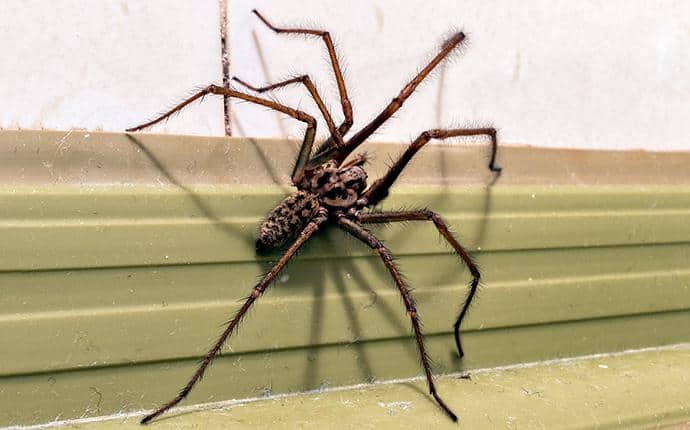
Giant house spiders, as their name suggests, are large arachnids that have up to a four-inch leg span. They appear in a variety of colors including dark orange, brown, and beige. These spiders have a tendency to build flat, messy webs often in corners and in areas that are not typically disturbed by humans.
-
Hobo Spiders
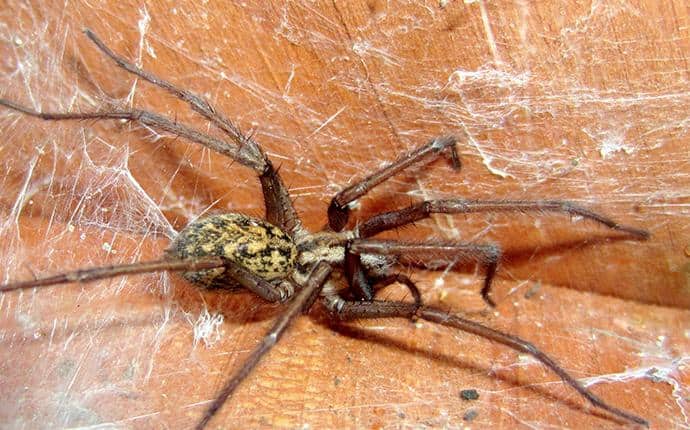
Similar in appearance to giant house spiders, hobo spiders are light to dark brown in color and have a single dark stripe running down the center of their bodies. Their long, thin legs are lighter in color and do not have any banding. Hobo spiders create funnel-shaped webs.
-
Wolf Spiders
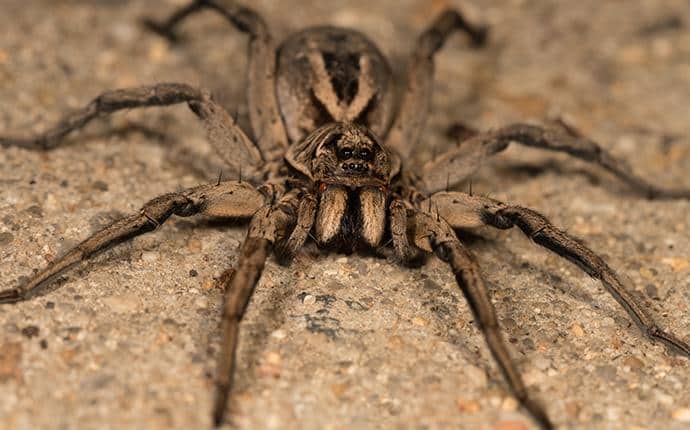
A large species of spider, wolf spiders have stout, sturdy bodies covered in hair and eight long, spiny legs. They are black or dark brown in color and may have cream, gray, or yellow markings. These spiders do not build webs. Instead, they hide out in burrows and move quickly to hunt down and capture their prey.
-
-
Types of Rodents
-
Deer Mice
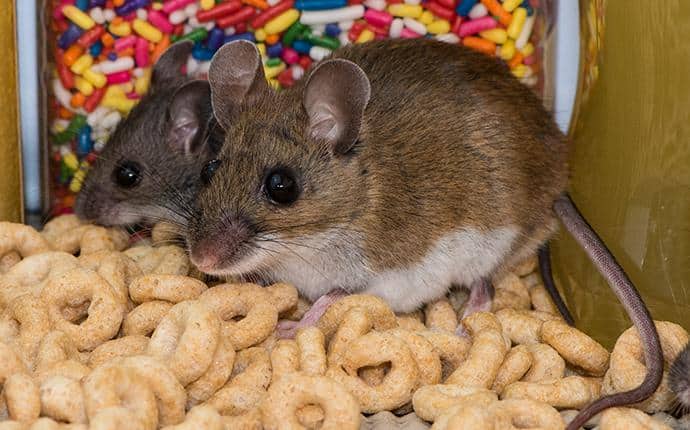
The adult deer mouse has a slender build and grows up to four inches in length (not including the tail which ranges from two to five inches in length). Deer mice have darker fur on top and lighter underbellies. They are also known for their large, fur-covered ears and piercing black eyes. Learn more about deer mice.
-
White-Footed Mice

Similar in appearance to the deer mouse, white-footed deer mice average about six inches in length including their tails and have darker coloring on top with lighter coloring on their undersides including their feet. They have noticeably large ears that are disproportionate to their bodies and bi-colored tails. Learn more about white-footed mice.
-
House Mice
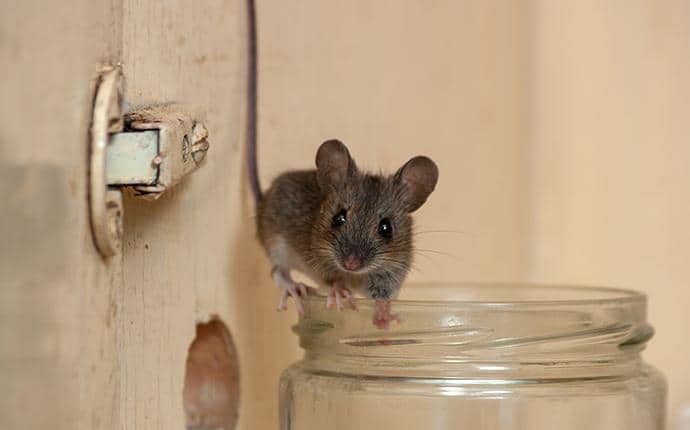
The common house mouse can grow up to 7.5 inches in length (that includes the body and tail) and is typically light brown in color. These mice have smooth fur, pointed muzzles, small eyes, and large ears. Learn more about common house mice.
-
Norway Rats
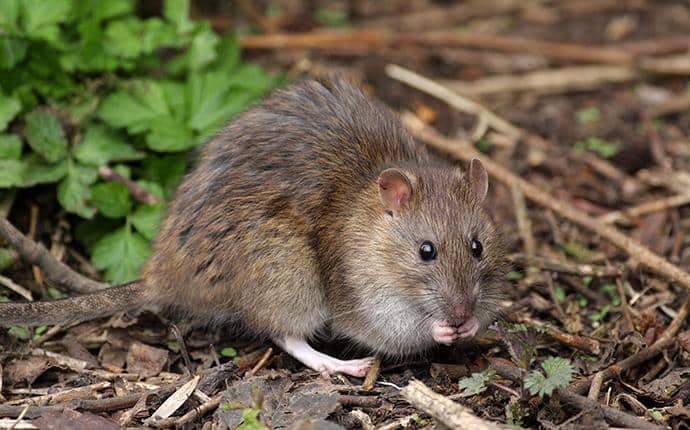
Norway rats have brown bodies with black hairs scattered in and lighter undersides. They are long, heavily-bodied rats that grow up to 17 inches in length including their tails. These rodents have blunt muzzles and small ears and eyes. Unlike roof rats, Norway rats are not skilled climbers and tend to inhabit lower levels of homes and businesses. Learn more about Norway rats.
-
Roof Rats
.2403171727550.jpg)
Dark brown or black in color, roof rats have long, slim bodies that grow up to 16 inches in length including their tails. Roof rats have large ears, pointed noses, and large, dark eyes. As their name suggests, roof rats tend to infest upper levels of structures and get there by utilizing their excellent climbing skills. Learn more about roof rats.
-
Wood Rats
.2403171728550.jpg) Also referred to as pack rats, this species belongs to the rodent genus Neotoma. They are rat-like in appearance with the exception of their tails. Unlike other rats, which have scaly tails, wood rats have bushy ones. They grow up to 18 inches in length, have ears larger than typical rats, and their coloring varies by age and even seasons. Learn more about wood rats.
Also referred to as pack rats, this species belongs to the rodent genus Neotoma. They are rat-like in appearance with the exception of their tails. Unlike other rats, which have scaly tails, wood rats have bushy ones. They grow up to 18 inches in length, have ears larger than typical rats, and their coloring varies by age and even seasons. Learn more about wood rats.
-
-
Types of Occasional Invaders
-
Centipedes
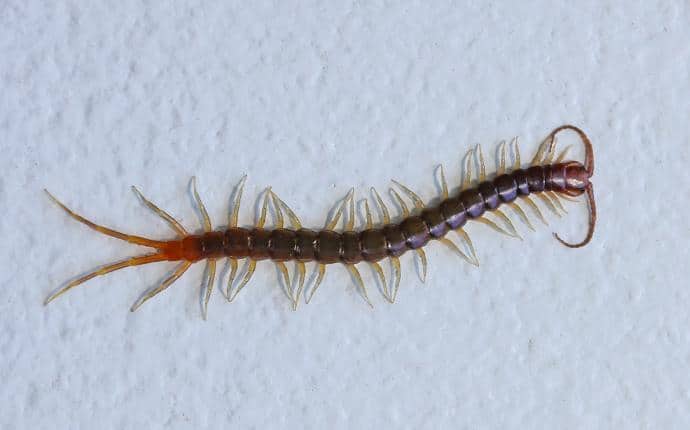
Another occasional invader with lots of legs, centipedes may have between 15 and 177 pairs of legs depending on their species. The first pair of legs on the centipede end in sharp claws that contain venom. This helps them capture and paralyze their prey. Centipedes have long, segmented worm-like bodies and range in color from yellow to dark brown. Learn more about centipedes.
-
Earwigs
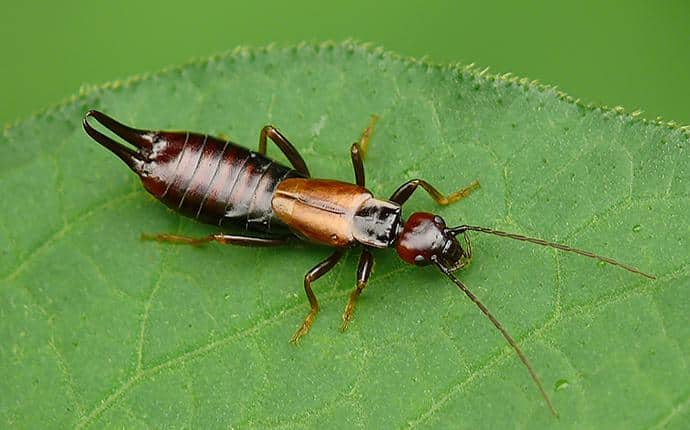
Fairly easy to identify, earwigs have long, smooth bodies that are dark brown to reddish in color. Extending of their abdomen are a pair of pincer-like appendages also known as cerci. Male and females can be distinguished by the shape of their cerci—males have curved pincers while females have straight ones. Most species of earwigs have wings but not all fly. Learn more about earwigs.
-
Millipedes
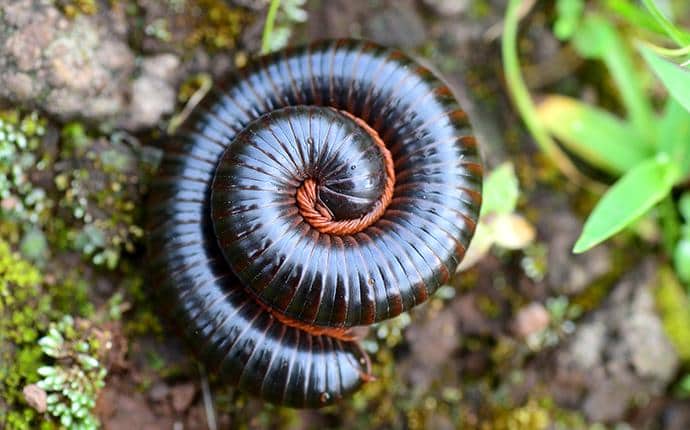
Millipedes have worm-like bodies that curl up into tight balls when threatened. Though their name might imply that they have thousands of legs, they may have up to 200 pairs of legs. Millipedes come in a variety of colors including dark, dark brown, red, and orange. They may also appear with a mottled pattern on their bodies. Learn more about millipedes.
-
Silverfish
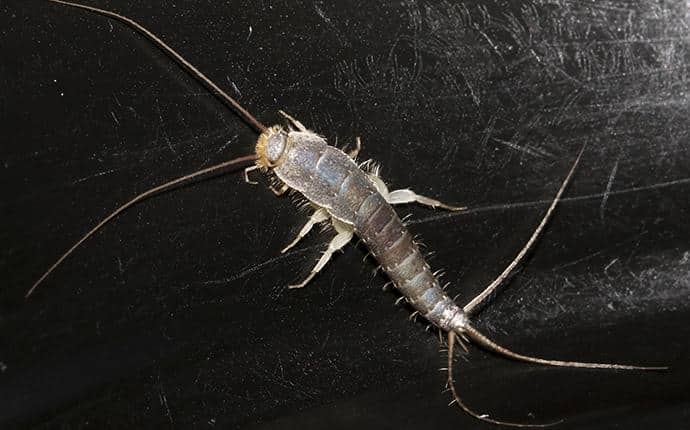
This occasional pest has an elongated teardrop-shaped body that is covered in bluish scales. They are not winged insects but have long antennae and three long bristle-like appendages that extend off their backends. Silverfish are commonly identified by the quick, fish-like way they move across the floor. Learn more about silverfish.
-
Springtails
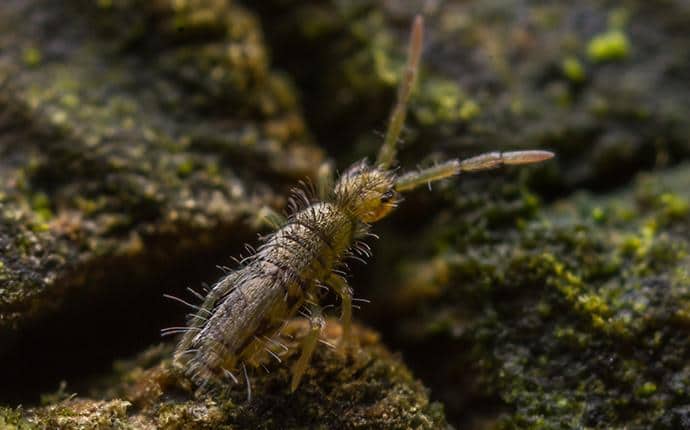
Small insects, springtails only grow up to about 1/8 of an inch. They have soft bodies that range in color. Their most distinctive feature is their furcular, which is a tail-like appendage located under their abdomen. This appendage is what gives them the ability to jump quickly out of harm's way. Learn more about springtails.
-
Lady Beetles
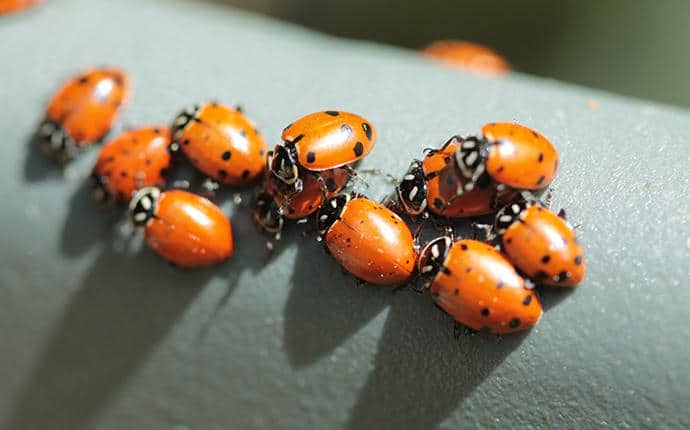
The Asian multicolored lady beetle, also known as the ladybug, is found in a wide variety of colors and patterns. Mostly seen in yellow, red, and orange, their bodies may also be covered by dark spots. They have smooth oval-shaped bodies that are domed and also have a unique “M” shaped mark found behind their head. Learn more about lady beetles.
-
-
Types of Mosquitoes
-
Northern House Mosquito
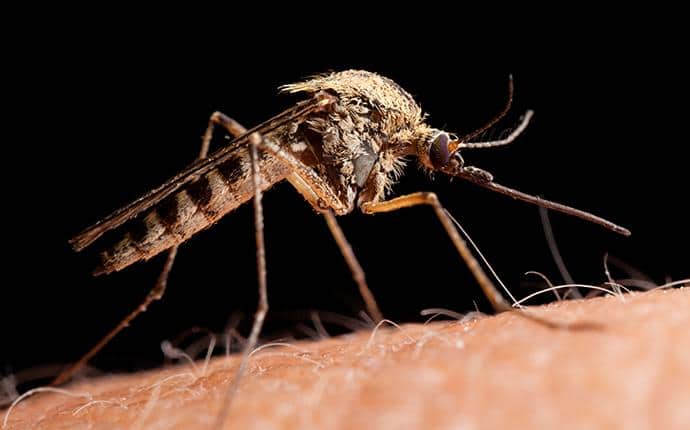
Adult Northern house mosquitoes (culex pipiens) have slender bodies, thin long legs, hairy wings and extended tube-like mouthparts that they use for feeding. Their bodies are covered in golden brown scales and their abdomens are marked with lighter color scales that form bands.
-
Western Encephalitis Mosquito
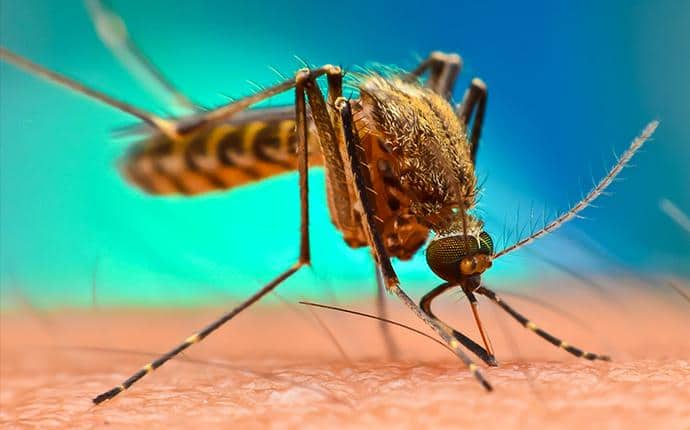
When fully matured, Western Encephalitis mosquitoes (culex tarsalis) have dark-colored bodies and white tube bands on their extended tube-like mouthparts. The underside of their abdomens have dark inverted Vs on them. They have white bands on their long, thin legs and a white stripe on the sides of their rear legs.
-
-
Types of Flies
-
Cluster Flies
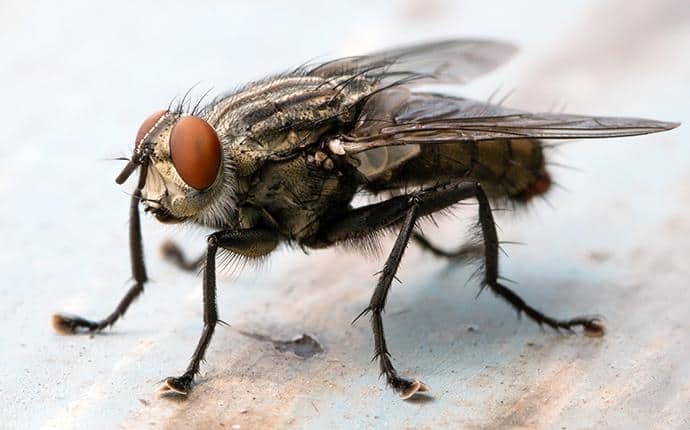
Slightly larger than house flies, cluster flies have long, narrow bodies that are dull gray in color. Their thoraxes and legs are covered in dark black and golden hairs and they have wings that overlap at the tips when not flying. Cluster flies typically enter homes in the late fall to overwinter and will “cluster” together inside of wall voids, in attics, and in crawl spaces. Learn more about cluster flies.
-
House Flies
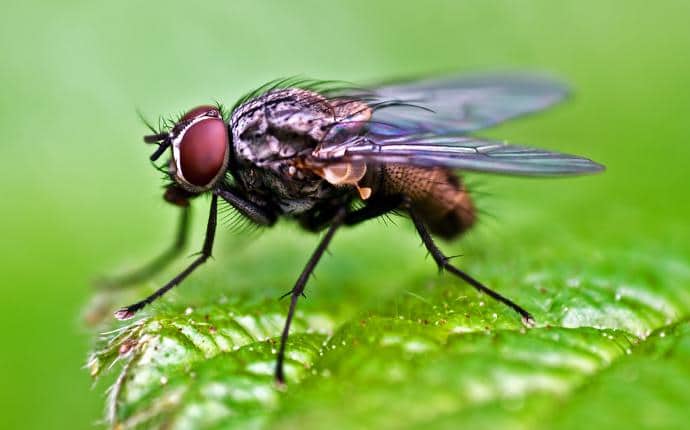
House flies are dull gray in color and have two velvety stripes on their faces and thorax. They also have four narrow stripes running the length of their bodies. Growing up to ¼ of an inch, house flies also have specialized spongy mouthparts that they use to feed on liquids. Their cream-colored, greasy-looking larvae have no eyes, no legs, and taper from rear to head. Learn more about house flies.
-
Drain Flies
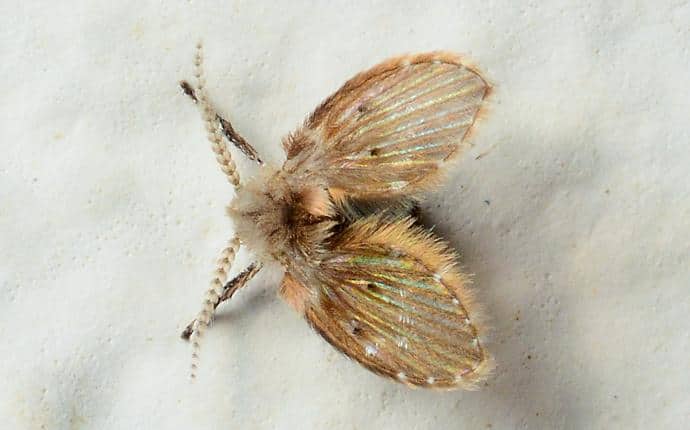
Dark or graying in color, drain flies have bodies that are covered in fuzzy hairs. Growing up to 1/8 of an inch in length, drain flies have large, horizontal wings which are also covered in fuzzy hairs. Though they have wings, they are poor fliers that fly in short, frenzied flight paths. Drain fly larvae are whitish in color, have a wormlike appearance, and are legless. Learn more about drain flies.
-
Fruit Flies
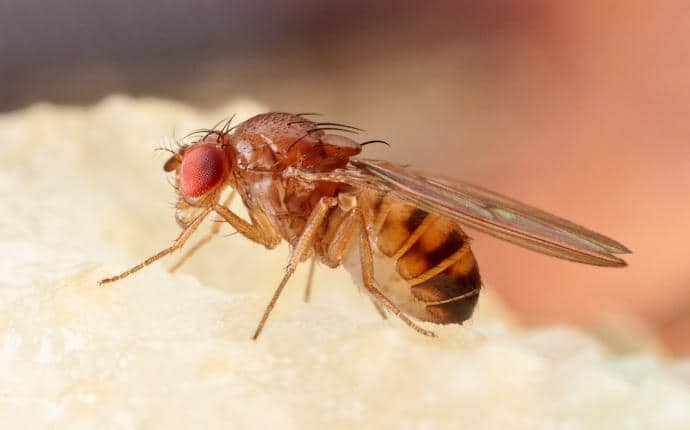
With yellowish-brown to brownish-black colored bodies and large compound eyes that are often red (they may also be brown or black), and translucent wings, the fruit fly is easily recognizable. Fruit flies are quite small, growing up to 1/8 of an inch in length. Fruit fly larvae have bodies that taper at the head and that are rounded at the back-end. They are whitish in color except for two dark-colored mouth hooks. Learn more about fruit flies.
-
Fungus Gnats
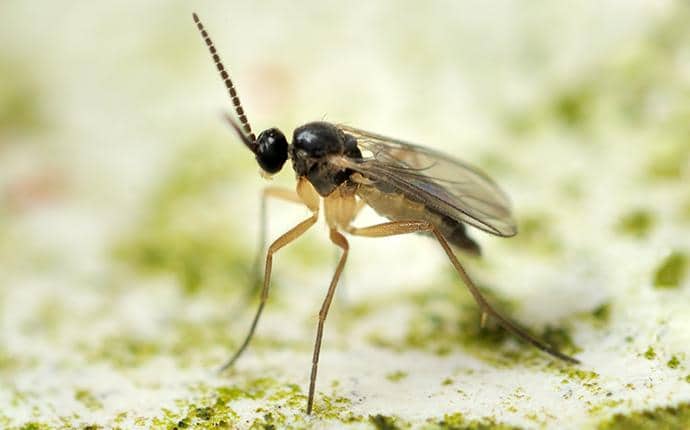
Fungus gnats have black or grayish-colored bodies, long thin legs, and smoky wings that have a unique Y-shaped pattern. A very small, frail fly species, fungus gnats look like tiny mosquitoes and grow to about 1/8 of an inch in length. Their larvae have worm-like bodies that are translucent. They also have a black head capsule. Learn more about fungus gnats.
-
-
Commercial Pest Control
-
What is Integrated Pest Management?
Ideal for schools, food processing facilities, and other commercial operations, Washington State University defines IPM as an effective and environmentally sensitive approach to pest management. IPM works by reducing sources of food, water, and shelter for pests and only using least-toxic pesticides when necessary. An effective IPM Program requires identifying and monitoring pest populations, and then selecting the most effective control methods with the least possible hazard to people, pets, and the environment.
-
What types of businesses does Prosite service?
At Prosite Pest Control, we provide commercial pest control services to a wide variety of businesses and industries including fruit packers, warehouses, data centers, fulfillment centers, hops production facilities, bakeries, restaurants, hospitals, hotels, schools, property management, and more!
-
Do you offer emergency pest control services?
We’ll discuss your specific needs and desires for service response and customize a management program to suit. As a general rule, we try to respond within 24 hours and certainly provide on call services as well.
-
Do you offer training for managers and staff?
Educating your employees is one of the most effective ways to prevent infestations. At Prosite Pest Control, we offer educational services that include training on how to identify pest problems quickly, how to respond if pests are identified, proper sanitation and prevention strategies, and more! For more information, please contact us.
-
Are recurring services necessary?
If your goal is to both rid your business of active pests and keep pests out in the future, then recurring services are very important. While our treatments are extremely effective at eliminating and preventing pests, they begin to break down over time. By providing on-going services to your business regularly, we maintain its protection and keep it pest-free.
-
What industries do you service?
We provide our pest control services to a wide range of industries. These include: Nursing Homes, Hospitals, And Other Healthcare Providers, Schools, Homeowners Associations, Condos And Apartment Buildings, Warehouses, Churches, Camps And Cabins, Office Buildings, Storage Facilities. If you don't see your industry listed above, please contact us to see if we can help!
-
How does your scheduling work?
We understand that treating pest problems in a business setting can be difficult. You need discretion and the least disruptive service possible. That's why we will work with you to develop a service schedule that works for your business's particular needs.
-
Do your treatment methods comply with our industry standards?
Every industry operates under certain guidelines, standards, and laws. When we develop your pest control program, we'll address those standards to ensure we are complying with your industry's protocols.
-
-
Home Pest Control
-
How much does residential pest control cost?
Your residential pest control costs depend on several factors, including your house size and the service plan you choose. Please contact us to receive a customized quote.
-
What is residential pest control?
Put simply; residential pest control is pest control to protect your home from pests. These services can include treatments to eliminate active pests, treatments to prevent future outbreaks, and services to help make your home and property less conducive to pest infestations.
-
Is pest control worth the money?
Many people think it makes the most sense to hold off on pest control until a pest problem arises. Unfortunately, at that point, it's often more costly to take care of the pests and the damage they've done. With preventative pest control, you can save money in the long run.
-
How often should I do pest control?
How often you have pest control services depends on a number of factors, such as if you have an active pest problem. We offer monthly, bi-monthly, and quarterly service plans to meet your needs. In general, when you go over 90 days without service, the treatment starts to break down, and pests begin to return.
-
Are pest treatments safe for my family and pets?
Homeowners frequently wonder if pest control measures are going to be harmful to their children and pets. What should be pointed out is that pests themselves can pose health and safety risks to household occupants. At Prosite, we employ environmentally conscious pest control applications designed to eliminate pest pressures while protecting people and pets.
-
What pests are covered by the SiteCare home pest control plans?
All three of Prosite's home pest control plans cover odorous house ants, pavement ants, little black ants, thief ants, harvester ants, small honey ants, Pharaoh ants, cornfield ants, carpet beetles, ground beetles, wolf spiders, cellar spiders, black widow spiders, blowflies, cluster flies, house flies, silverfish, earwigs, millipedes, centipedes, stink bugs, gnats, box elder bugs, and crickets.
In addition to the pests mentioned above, our SiteCare Advantage and SiteCare Complete offer protection against other insects and rodents. For more information, please reach out!
-
Is year-round home pest control necessary?
In 1736, Benjamin Franklin advised fire-threatened Philadelphians that "An ounce of prevention is worth a pound of cure.” This same principle holds true with pest control and your home. Preventative maintenance is far more economical than the corrective measures taken to turn an active infestation around. At Prosite Pest Control, our initial service will treat existing pest problems and with ongoing visits and free re-treatments if necessary, will ensure your home remains pest-free.
-
-
Exclusion
-
What is pest exclusion?
Plain and simple, pest exclusion is the act of keeping rodents and wildlife out. Unfortunately these pests are adept at finding entry points into homes, and once inside, they'll make themselves quite comfortable. At Prosite, our exclusion services focus on identifying entry points and then correcting them. That could be as simple as sealing a crack on the exterior of the foundation or installing a door sweep or it could be larger and broader in scope. When you contact us, we'll develop a prevention place that ensures rodents and wildlife cannot invade your home.
-
Can you really figure out how mice are getting in and seal them out?
Absolutely, we can. Our pest control technicians are highly trained and licensed professionals well-versed in both rodent behavior and effective exclusion techniques. We know how to get rid of mice and rats as well as wildlife AND how to keep them out!
-
Does every hole need to be patched?
Even a small gap under the garage door or crack in the foundation could be a potential entry point for opportunistic rodents. In fact, mice can fit through holes as small as the end of a #2 pencil and rats can fit through openings the size of a quarter. In order to protect yourself from rodents and wildlife, we recommend addressing every potential entry point.
-
What pests can you prevent?
Our expert pest-proofing services will get rid of squirrels that are trying to get in, prevent small animals (such as raccoons and skunks), stop bats from infesting your attic, and get rid of rodents that are trying to invade your home! For rodent prevention or wildlife prevention, please reach out.
-
What if I already have rodents or wildlife in my home?
Before we can keep these pests out, we must evict them! At Prosite Pest Control, we offer property owners in Ellensburg, Yakima, Grandview, and throughout Yakima and Kittitas counties solutions that include rodent trapping and removal, skunk removal, and other wildlife removal solutions. Simply give us a call or fill out the form and we'll reach out to discuss!
-
-
Types of Cockroaches
-
German Cockroaches
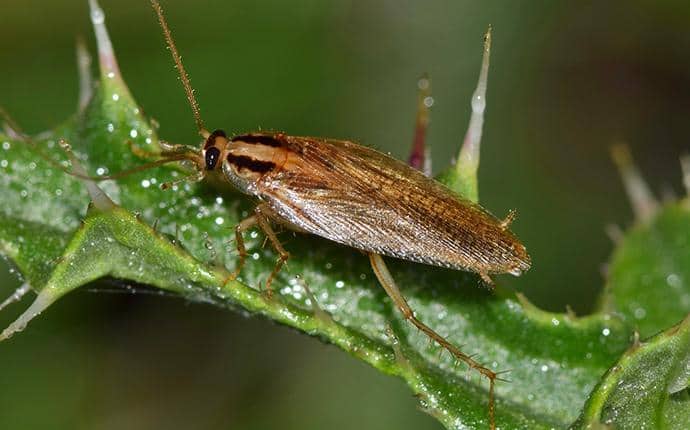
German roaches have flat, oval-shaped bodies that are light brown or tan. They also have two black stripes behind their heads. Females of this species have wider abdomens than their male counterparts. Both sexes have fully developed wings but do not fly. Learn more about German cockroaches.
-
American Cockroaches
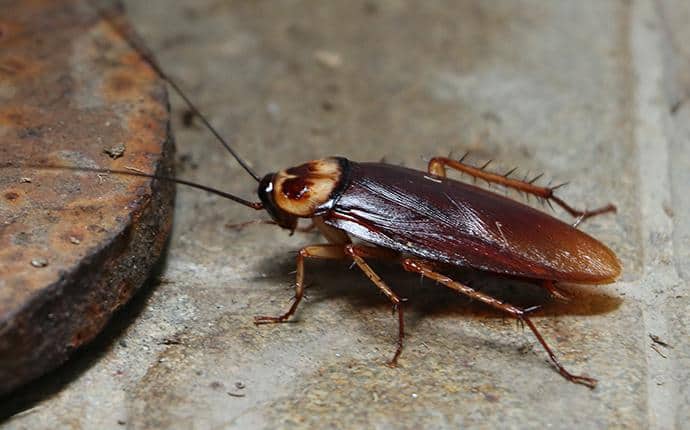
The largest house-infesting roach in our region, American cockroaches are reddish-brown in color and have a lighter color outlining their bodies. They also have a yellowish figure-8 pattern behind their head. Both the males and females are winged and are strong fliers. Learn more about American cockroaches.
-
Oriental Cockroaches
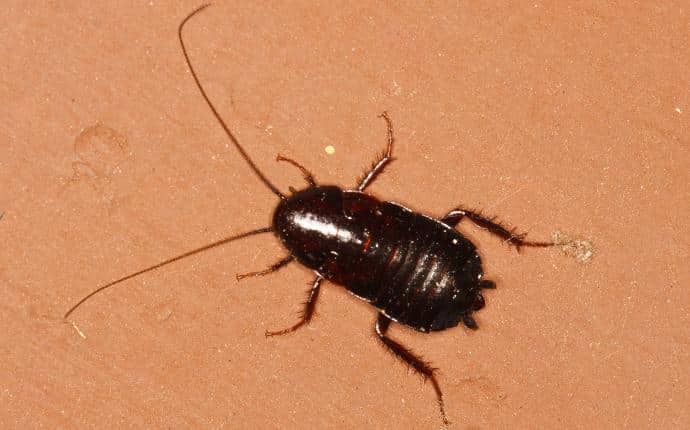
Oriental cockroaches are known for their smooth, shiny black bodies. Females have wider bodies than males. Neither are capable of flight. Another distinguishing characteristic of Oriental roaches is the unpleasant musty smell they produce. Learn more about Oriental cockroaches.
-
Brownbanded Cockroaches
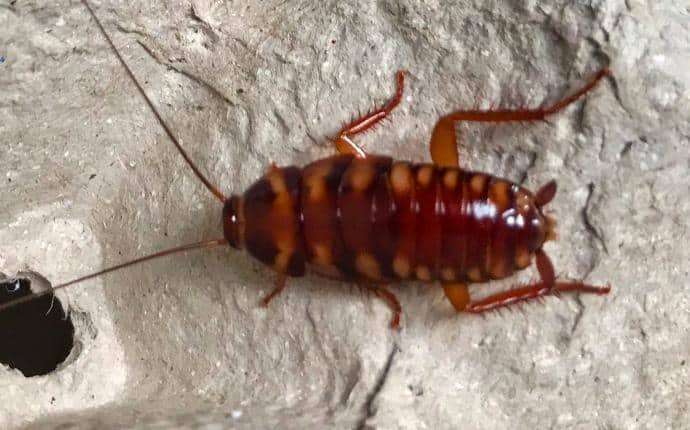
Only seen occasionally in Washington state, brownbanded cockroaches are a smaller species. Females are shorter than males and have stockier, heavier bodies. Females have undeveloped wings that are reddish-brown to dark brown in color. Males have wings that are dark brown in color at the base and lighter towards the tips. Brownbanded cockroaches have unique tan bands that cross their wings. Learn more about brownbanded cockroaches.
-
-
Types of Ants
-
Odorous House Ants
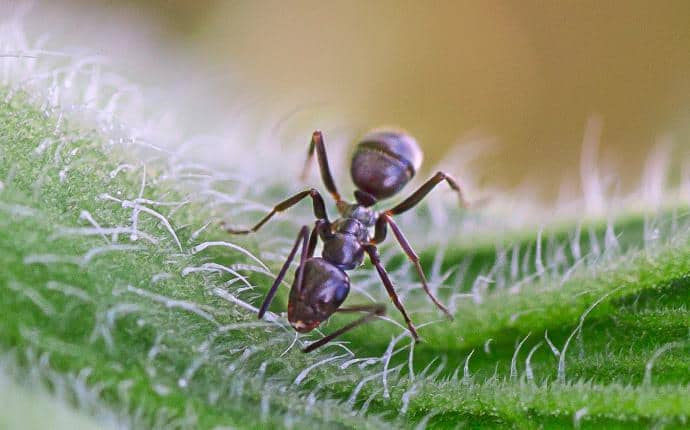
Aptly named, odorous house ants are small dark-colored ants that may produce an unpleasant rotten, coconut-like smell when crushed. More commonly referred to as sugar ants, these pests are frequently found in kitchens and bathrooms. Learn more about odorous house ants.
-
Carpenter Ants
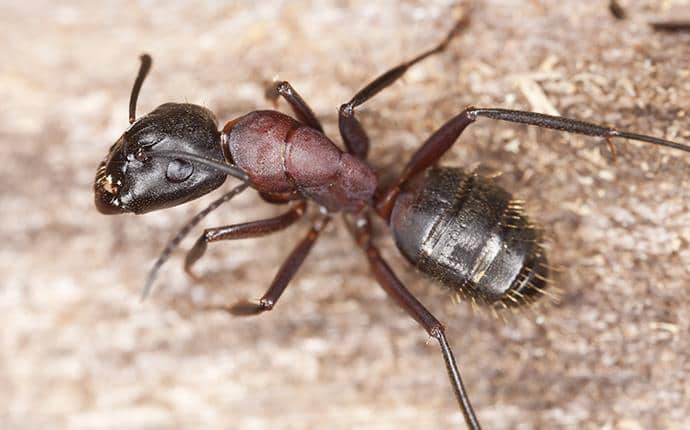
In the Pacific Northwest, carpenter ants are black, red, or a combination of the two colors. They are large ants that nest in live or dead trees including stumps and logs. They also have a tendency to establish satellite colonies in structures. These large ants are often mistakenly identified as termites and while both are wood-destroying pests in Washington, they are two completely different species. Learn more about carpenter ants.
-
Pavement Ants
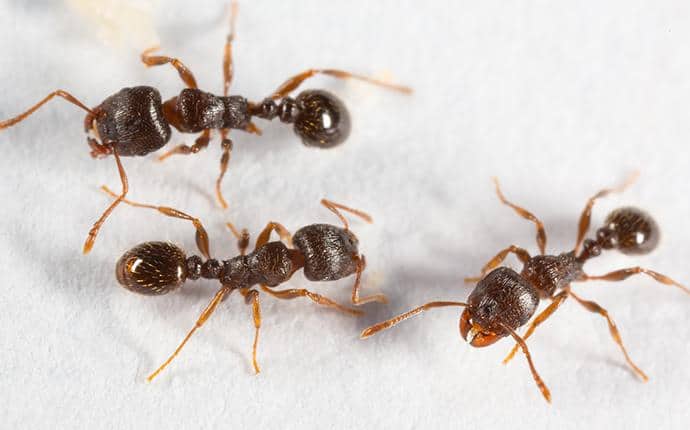
Brown to black in color, pavement ants are commonly found nesting in exposed soil along driveways and sidewalks and can also be found in cracks in pavement and cement. Considered nuisance ants they will enter homes and structures in search of food. Learn more about pavement ants.
-
Velvety Tree Ants
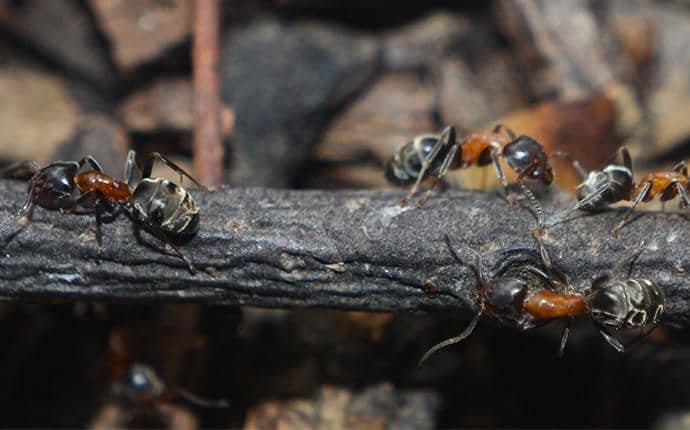
Velvety tree ants have brownish-black heads, yellowish-red thoraxes, and black abdomens that are covered in dense fine hairs. Those hairs are why they are described as “velvety”. As their name suggests, velvety tree ants make nests in tree crooks as well as stumps and logs. When they infest homes and buildings, they often make temporary nests close to food sources. Velvety tree ants are sometimes confused with carpenter ants because of their nesting habits and the damage that results from them. Learn more about velvety tree ants.
-
Pharaoh Ants
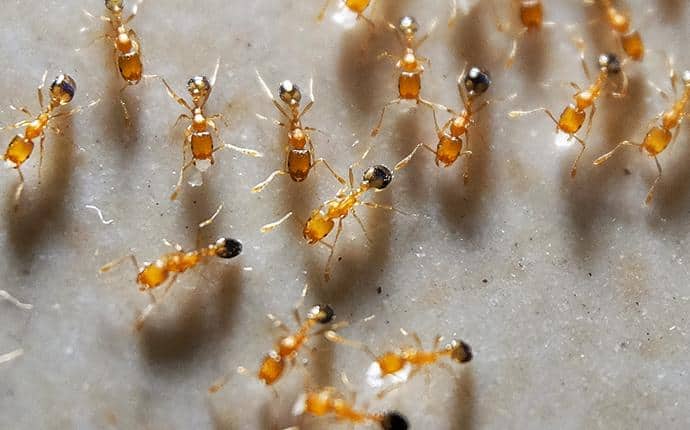
Pharaoh ants are yellow or light brown ants that were originally from Africa. They are omnivorous ants that will infest homes and businesses in an effort to find food and are considered obnoxious ants because they get into everything. In hospitals and clinics, they have been found in patient wounds and IVs. These ants, along with Argentine ants are not a major ant pest for our region but are occasionally seen. Learn more about pharaoh ants.
-
-
Helpful Resources
-
Ants
- Yakima County's Step-By-Step Guide To Effective Ant Prevention
- What Every Yakima County Resident Should Know About Ant Control
- How To Get Rid Of Ants In Your Kittitas County Home And Keep Them Out
- Winning The Battle Against Ants In Kittitas County: Expert Advice On Effective Control
- The Key To Keeping Your Yakima County Home Odorous House Ant-Free
- The Right Way To Prevent Ants From Entering Your Yakima Home
- Say Good Riddance To The Ants In Your Kittitas County Home
- Ant Control Maintenance: Keeping Your Kittitas County Home Ant-Free Long-Term
- Ant Control 101: A Helpful Guide For Kittitas County Homeowners
- The Problem With Odorous House Ants In Kittitas County
- Getting Rid Of An Ant Infestation In Your Kittitas County Home
- The Most Effective Ant Control Solution For Kittitas County Properties
- The Do's And Don'ts Of Ant Control: An Extensive Guide For Kittitas County Homeowners
-
Bed Bugs
- Are Bed Bugs In Yakima County Dangerous?
- How Bed Bugs Get Into Yakima County Homes In The First Place
- The Secret To Effective Do-It-Yourself Bed Bug Control In Kittitas County
- What It Takes To Get Rid Of A Bed Bug Infestation In Your Yakima County Home
- What To Do If You Think Your Kittitas County Home Has Bed Bugs
- The Ultimate Guide To Effective Bed Bug Control For Yakima County Homes
- Are These Bed Bugs In My Yakima County Home?
- How To Spot A Bed Bug Infestation In A Commercial Building In Yakima County
- Why Bed Bug Infestations In Washington Homes Are So Difficult to Prevent
- Identifying And Getting Rid Of Bed Bugs In Your Yakima County Home
- Don't Let The Bed Bugs Bite: The Effective Control Solution For Your Yakima County Home
- What's The Best Way To Get Rid Of A Bed Bug Problem In My Home In Yakima County?
- Common Myths Associated With Bed Bugs In Yakima County
- How You May Be Wrong About Bed Bugs In Yakima County
- Why Do I Have Bed Bugs In My Yakima County Home?
- Why Do I Have Bed Bugs In My Kittitas County Home And How Do I Get Them Out?
- Winning The Battle Against Bed Bugs: Effective Control Strategies For Yakima County Homes
- The Bed Bug Battle: Effective Bed Bug Control Strategies For Kittitas County Homes
- A Strategic Guide To Long-Term Bed Bug Control In Yakima County
-
Carpenter Ants
-
Cockroaches
- Central Washington's Secret To Effective Cockroach Control
- Why Is It So Hard To Get Rid Of Roaches In My Kittitas County Home?
- Early Warning Signs Of Roaches In Your Yakima County Home
- Eliminating Cockroaches For Good: A Comprehensive Approach For Yakima County Homes
- Expert Techniques For Effective Cockroach Elimination For Kittitas County Homes
- Keep Cockroaches Out Of Your Kittitas County Home
- The Key To Effective German Cockroach Control In Yakima County
- How To Keep Roaches Out Of Your Kittitas County Home
- Cockroach Control Done The Right Way For Kittitas County Homeowners
- What's The Best Way To Get Rid Of Cockroaches In My Kittitas County Home?
- What To Do About Cockroaches In Yakima County Home
- What Yakima County Property Owners Should Know About American Cockroaches
- How To Keep Roaches Out Of Your Kittitas County Home
- Say Goodbye To Cockroaches In Your Yakima County Home
-
Commercial Pest Control
-
Earwigs
-
Fleas
-
Flies
-
Home Pest Control
-
Mosquitoes
-
Rodents
- How To Keep Rodents From Invading Your Yakima County Restaurant
- Signs Of Rodent Infestation In Washington Homes
- The Trick To Getting Rid Of Mice In Your Kittitas County Home
- Yakima County's Handy Guide To Norway Rats
- Rodent Control Done Right For Yakima County Properties
- How To Keep Rodents At Bay: Tips For Effective Pest Prevention For Yakima County Homes
- Kittitas County Property Owners Complete Roof Rat Control Guide
- The Secret To Keeping Mice Out Of Your Yakima County Home
- Tips To Getting Rid Of Rats & Mice In Your Kittitas County Home
- Mouse Control 101: A Complete Guide For Yakima County Homeowners
- The Importance Of Effective Rodent Control For Yakima County Property Owners
- Effective Rodent Control Solutions For Yakima County Homes
- How To Keep Rodents At Bay: Tips For Effective Prevention For Yakima County Homes
- Kittitas County Total Rodent-Prevention Guide
- The Trick To Effective Rodent Control In Kittitas County
- Why You Should Call The Pros About Rodents In Your Yakima County Home
- Rodent Control: A Complete Identification And Control Guide For Yakima County Homes
- Rodent Rundown: Keeping These Dangerous Pests Away From Your Kittitas County Property
- Keeping Rodents Out: Expert Control Strategies For Yakima County Properties
- Rodent Control 101: Essential Tips For Keeping Your Yakima County Home Safe
- How To Stop The Rodent Problem In Yakima County
-
Silverfish
-
Spiders
- Five Easy Ways To Keep Spiders Out Of Your Kittitas County Home
- What Should I Do About Cellar Spiders In My Kittitas County Home?
- The Best Way To Keep Spiders Out Of Your Kittitas County Home
- Spider Wars: How To Win The Battle Against Arachnids In Kittitas County
- How To Get Rid Of Spiders In Your Yakima County Home
- What To Do If You Spot Spider Webs On Your Kittitas Property
- Are The Spiders In Kittitas County Dangerous?
- Spiders Be Gone: A Guide To Keeping Spiders Out Of Your Kittitas County Home
- What You Need To Know About Spiders In Kittitas County
- Should I Be Scared Of the Spiders I Encounter In Kittitas County?
- What You Should Know If You Are Seeing A Lot Of Spiders Around Your Yakima County Home
- A Handy Guide To Spider Prevention For Yakima County Homes
- How To Keep Spiders Out Of Your Yakima County Home: Tips For Effective Spider Prevention
-
Stinging Insects
-
Termites
- How To Spot Termite Damage On Your Kittitas County Property
- What Every Kittitas County Homeowner Should Know About Termites
- The Most Effective Way To Protect Your Yakima County Home From Termites
- How To Protect Your Kittitas County Home Against Termites
- How To Tell If Your Kittitas County Property Has A Termite Problem
- When Are Termites Active In Central Washington?
- The Best Way To Handle A Termite Infestation In Your Kittitas County Home
- How To Get Rid Of Termites: A Comprehensive Guide For Kittitas County Homeowners
- The Best Termite Protection For Your Yakima County Property
- How Much Damage Can Termites Do In Your Yakima County Home?
- Termite Control In Yakima County: Everything You Need To Know
- The Ultimate Guide To Effective Termite Control For Kittitas County Properties
-
Ticks
-
Wildlife
-
Wood Destroying Pests
-
-
Spray Foam Insulation
-
What are the benefits of spray foam insulation?Spray foam insulation brings a number of benefits to homeowners or property managers that opt to utilize it. Spray foam insulation is easy to install, long-lasting, and helps solve several potential problems at once. In addition to helping lower your energy costs and moderating temperatures within your home or office, it will also help repair existing holes or gaps in the structure, prevent future moisture problems from developing, and deter pests from getting inside.
-
How does spray foam insulation save homeowners money?While spray foam insulation treatment requires an initial upfront payment for application, it is an investment that can save you hundreds of dollars every year once it has been installed. Drafts and leaks that let outside air inside force heating and air conditioning units to work harder to make up the difference. When spray foam is applied, it seals these cracks and holes as it expands, allowing air to flow freely and reducing the energy required to heat or cool your home. In fact, most spray treatments pay for themselves within three to five years.
-
Can spray foam insulation help with pest problems?Yes, in a number of ways. Beyond repairing existing holes that pests like rodents might have chewed into your home or office, it also serves as a natural deterrent to future pest problems as the materials inside it can’t be used as food or nest material. Likewise, the fact that it helps prevent water from seeping in makes your home less attractive to pests like termites that are drawn to moisture-damaged wood.
-
How can spray foam insulation prevent moisture damage in homes?Unlike typical fiberglass or foam board insulation, which must be replaced if it gets wet, spray foam insulation actually works as a natural moisture deterrent that retains its properties no matter how wet it gets. Any gaps in your siding or around your home’s pipes and vents allow water to seep through, putting you at risk for moisture damage. While traditional insulation retains a steady shape and position once installed, spray foam expands to fill even the smallest gaps that might be present in these areas, preventing moisture from getting in.
-
How can spray foam insulation improve air quality in my home or office?Like moisture, airborne particles and pathogens can get into your home or office through the smallest of gaps around your home, even seeping in through the walls themselves. Spray foam fills these gaps in a way traditional insulation cannot, minimizing the amount of dust, mold, mildew, pollen, and other particles can get inside. This factor makes spray foam insulation an excellent choice for people that suffer from allergies, asthma, or other chemical sensitivities.
-
How difficult is the installation process for spray foam insulation?Part of spray foam’s popularity comes from how easy it is to install. Installation is a non-invasive process that allows professional applicators to seal even hard-to-reach areas like attics and crawl spaces with little hassle and minimal preparation required by the homeowner. The process is also quick, with insulation taking only about a day to dry. Spray foam insulation can be applied during any time of the year.
-
How long does spray foam insulation last?Decades. Once applied, spray foam takes about a day to take shape and fully dry. After the spray foam has cured, it holds its form even in extreme temperatures. Unlike traditional insulation which deteriorates and loses effectiveness over time, the combination of polyurethane and isocyanate in spray foam makes it keep form for years without sagging or shifting - no upgrades or replacement required.
-
Is spray foam insulation environmentally-friendly?Yes. Spray foam is made with non-toxic chemicals that won’t release harmful contaminants into the air when applied. Even better, by helping home and business owners use less energy to heat and cool their buildings, spray foam reduces their own carbon footprint.
-
Can spray foam insulation damage building materials?No. On the contrary, spray foam improves the structural integrity of buildings it is applied to. The strong adhesive quality within spray foam works like glue to hold building materials together, acting as an extra layer of protection against natural forces that can deteriorate buildings over time like wind and rain.
-
How will spray foam insulation affect the comfort level of my home?Spray foam insulation makes homes more comfortable to live in. Beyond maintaining a more consistent temperature with minimal fluctuations, spray foam insulation also reduces drafts, improves air quality, mutes noise from road traffic or other rooms, and helps maintain a comfortable, dry atmosphere within the structure. And of course, it’s hard for anyone to be comfortable when a pest infestation is underway, and spray foam seals many of the holes and gaps they could potentially use to get inside.
-
Is spray foam insulation worth it?Absolutely. Spray foam is an investment that can pay huge dividends as the years go by, both in direct energy savings and in the many problems it can help stop from developing in the first place. The benefits are numerous, and compound over time.
-
-
Clean-Up & Odor Control
-
Can I clean up rodent droppings?
When it comes to cleaning up rodent droppings, we highly recommend leaving it to the professionals. You can get sick from rodents and the diseases they’re associated with are transmitted through their droppings and urine. Prosite has the knowledge and tools to properly remove droppings and sanitize contaminated areas.
-
Can I clean up bat poop?
Histoplasmosis is an infection caused by breathing spores of a fungus that can be found in bat droppings. The risk of transmission increases when the spores become airborne. Without the right equipment or proper training, you could expose you and your family to this serious infection.
-
I found a rodent nest, what should I do?
If you’ve found a rodent nest or even a dead rodent, we would encourage you to reach out for help. A rodent nest is a definite sign of an infestation and simply removing it will not stop rodent activity. Nesting material may also be contaminated by droppings and urine and have the potential to expose you to serious health conditions.
-
If the problem is too severe for Prosite, what do I do?
Prosite has relationships with excellent contractors throughout Central Washington. If we do not have the capability to resolve your problem, we’ll point you in the right direction.
-
-
Sanitation
-
How does bioremediation work?
Bioremediation uses naturally occurring microorganisms to break down hazardous materials and other substances. When injected into drains, drain lines, or other equipment or areas, the bacteria will degrade or digest the built up material which supports your other sanitation efforts and pest prevention.
-
Should I have my facility sanitized if I encounter rodent evidence or nesting?
Yes! Rodents and other pests such as phorid flies or cockroaches have serious potential to contaminate not only your facility but your products as well. Intense professional cleaning and disinfecting by the staff highly trained at Prosite will give you peace of mind.
-
-
Food Safety
-
What is the FDA Food Safety Modernization Act (FSMA)?
The FDA Food Safety Modernization Act, signed into law on January 4, 2018, enables FDA to better protect public health by strengthening the food safety system. It also enables the FDA to focus more on preventing food safety problems rather than reacting to problems after they occur.
-
What pests threaten our food supply the most?
In an article published by Quality Assurance & Food Safety, Cindy Mannes of the NPMA noted that food processing facilities offered the perfect conditions for rodents, cockroaches, and flies.
-
-
Bat Removal
-
How small of an opening do bats need to get in?
Bats can squeeze through gaps as small as 3/16 of an inch.
-
Are bats dangerous?
On their website, the Washington Department of Fish & Wildlife estimates that 5–10% of sick, injured, or dead bats tested by their agency have rabies. It is also their estimation that less than one percent of the native wild population has rabies.
-
What should I do if I’ve been bitten or scratched by a bat?
If you’re concerned that you’ve been exposed to a rabid bat, the WDH recommends washing the wound, contacting your doctor, and if possible, capturing the bat to send out for testing.
-
What are common signs of a bat infestation?
Oddly enough, bat infestations are often misdiagnosed as rodent problems. In fact, many homeowners who find droppings on their porch assume they have a rodent issue but bats frequently roost on porches in our region. Other signs of a bat infestation include:
- Seeing bats fly in through ridge cap.
- Oil stains at entry and exit points.
- Urine running down walls.
- Droppings falling from the ceiling.
- Bat guano and urine accumulating in the attic
- High pitched squeaking sounds.
-
How do I stop bats from roosting on my porch?
Bats hate to roost in well-lit areas so we recommend directing soft floodlights in areas prone to roosting.
-
Why is my home attracting bats?
Metal roofs and chimneys are known to attract bats. Gaps and holes along the structure may also provide ample opportunity for bats looking for roosting sites.
-
How do I attract bats?
Here at Prosite, we recognize the value bats have in controlling other insects and so understand why homeowners might want to attract them to their property. Bat houses are a great way to encourage bat activity. We just don’t recommend installing them too close to your structure.
-
-
Wildlife Control
-
Do you provide wildlife control services in Spokane?No, we only offer wildlife control services to customers in Kittitas & Yakima counties.
-
How much does Prosite’s wildlife control services cost?
Pricing for wildlife control depends on the situation. We’ll provide a consultation to determine the type of wild animal, the scope of the infestation and if exclusion services are needed. Based on the assessment we’ll provide a quote.
-
Is same day service available for wildlife control services?
Yes, Prosite offers same day service. When we come out to inspect, we’ll be ready to implement your customized wildlife control plan.
-
What time of year do raccoons have their babies?
In Washington, raccoons mate as early as January to as late as June. March and April are the considered peaking months for mating. The gestation period is typically 65 days so if you’re hearing noises coming from above, it could be a mama raccoon and her pups. It is very common for raccoons to give birth to their babies in attics but also chimneys and other den sites they’ve deemed secure.
-
Can I get sick from wildlife?
Yes. On their website, the Washington State Department of Health provides a comprehensive list of animal-transmitted diseases including leptospirosis, Baylisascaris (or raccoon roundworm), rabies, and salmonellosis. How disease is transmitted varies but includes direct contact with feces and urine, scratching, or biting.
-
Are raccoons, skunks, and other small wildlife dangerous?
If cornered, threatened, or even sick, wildlife may become aggressive and attack. For that reason, we highly recommend contacting a company that specializes in wildlife removal if you’ve discovered a problem in your home or business.
-
Does Prosite Pest Control offer marmot control?
If you’re looking for structural marmot control, we may be able to help. Give us a call to discuss your specific situation. Unfortunately, we do not offer marmot control for open fields.
-
-
Termite Control
-
What type of termite is most active in our region?
Western subterranean termites are the species most often found in Central Washington. To learn more about this pest, please visit our termite identification page.
-
Are termites the only wood-destroying pest in Washington?No, carpenter ants are another wood-destroying insect that can cause serious damage if not treated. Interestingly enough, carpenter ants don’t actually consume wood, they tunnel through it in order to create nesting galleries. Termites on the other hand, consume wood because it gives them the nutrients they need to survive.
-
I’ve noticed sawdust on the floor, is that from termites?
The culprits are probably carpenter ants. As mentioned above, carpenter ants do not eat wood and so as they tunnel they push the “frass” out of their entry points. That is likely the sawdust you’re seeing on the floor (especially if you notice pinholes in the wall above the sawdust).
-
How do you tell the difference between a termite swarmer and a winged ant?Termites are lighter in color, more of a creamy white; carpenter ants are darker. Termites have straight antenna; carpenter ants have bent antenna. Both insects have four wings but termite wings are all the same size. Carpenter ants have two small hind wings and two larger forewings.
-
-
Bird Control
-
Are bird spikes lethal?No, bird spikes are not lethal and are designed to prevent pest birds from perching or roosting on rooftops, parapet walls, signage, and other exterior surfaces.
-
I’ve noticed holes on the side of my house, what is causing the damage?
It’s very common for woodpeckers in Central Washington to cause damage to sides of houses and buildings. According to Cornell Lab of Ornithology, woodpeckers drill holes for a couple of reasons.
Holes made by drumming activity is usually part of breeding or territorial behaviors.
Holes established for roosting or nesting purposes are typically larger holes surrounded by smaller ones. You most often see these at the beginning of breeding season (between late April and early May)
Foraging holes are created by woodpeckers as they try to locate insect infestations. They can be identified by the vertical line of holes drilled.
-
-
Rodent Control
-
What type of rats and mice commonly infest homes and businesses in our area?
In Yakima and Kittitas counties and throughout Central Washington, the roof rat, white-footed mouse, and deer mouse are the most common types of rodents. Visit our rodent pest identification to learn more.
-
How do I tell the difference between mice and rats?
From head to tail mice are smaller than rats by several inches. Mice also have smaller droppings (6 mm vs 12 mm) and gnaw marks (2 mm vs 4 mm) than rats. Mice have larger ears and pointy or triangular noises whereas rats have small ears and blunt noses. Both have long tails but mice have thin, hairy tails. Rats on the other hand have thick, scaly tails devoid of hair.
-
Can I get sick from rodents?
Yes. According to the Centers for Disease Control and Prevention (CDC), rodents have the potential to directly transmit several diseases including Hantavirus Pulmonary Syndrome, Leptospirosis, rat-bite fever, and Salmonellosis. They also introduce ticks, mites, and fleas onto properties. While Washington has very few cases of Lyme disease and other tick-borne diseases, the link between rodents and ticks should be noted.
-
I have hantavirus, did rats give that to me?
In our region, rats are not normally the carriers of hantavirus. Unfortunately, white-foot and deer mice are and we have those in abundance.
-
I have rodents in my house, how much is it going to cost?
The cost of rodent control depends on several factors including the type of rodent, the severity of the infestation, the size of the structure, and if exclusion services are necessary. When you reach out to Prosite Pest Control, we’ll provide a consultation. Once we’ve assessed the situation, we’ll communicate our findings and recommendations, and of course, provide you with a quote for the treatment.
-
How do you control rodents?
Rodents are dangerous pests that spread illnesses and cause serious damage to your house. Controlling a rodent infestation requires skill, experience, and attention to detail. Prosite Pest Control provides rodent control using a variety of methods that are proven to work.
-
How much does rodent control cost?
Each rodent infestation is unique and requires a different combination of treatment methods. If you have a rodent problem, we'll perform an inspection of your home, then provide you with a quote based on the treatment plan we draw up for your house.
-
How to control pests and rodents?
A home that is unprotected can easily become infested by pests and rodents. In order to control them, you need the proper pest or rodent control systems in place. While you can do some pest control yourself, professional pest control gives you the extra peace of mind.
-
What is rodent control?
Rodent control is a combination of services and treatments designed to remove rodents from your home and prevent future infestations. These services and treatments include setting up traps and bait stations and performing sanitation and exclusion work.
-
-
Bed Bug Control
-
Where do bed bugs come from?
Unfortunately, you can pick up bed bugs anywhere. Hotels, movie theaters, airports, plans and cabs are common places to encounter these bugs. Homeowners also risk bringing them home on used clothing and secondhand furniture or welcome guests that have arrived with stowaways on their luggage or even themselves.
-
Does Prosite offer organic bed bug treatments?
Yes, we do! To learn more about our organic bed bug control methods, please give us a call.
-
Which is more effective - bed bug heat treatment or chemical?
Both methods are highly effective in eliminating bed bugs from residential and commercial properties. The solution we recommend is based on the size of the infested area, the severity of the infestation, and other factors. Once we’ve inspected the problem area, we’ll have a better idea of which treatment would be better suited.
-
How does a bed bug heat treatment work?
Heat treatment is very effective in killing adult bed bugs, eggs, and nymphs because the heated air is able to eliminate bed bugs found on the surface AND penetrate fabrics and areas not easily accessed by technicians such as cracks and crevices in flooring and furniture.
Professional grade thermal remediation equipment is set up in the infested area after the preparation work has been completed. Under the careful eye of one of our trained technicians, the space is then heated up to a temperature that is proven to eliminate bed bugs and sustained for several hours. During the course of treatment, the intense heat will dehydrate the bugs causing them to die. Once complete, our team will break down our equipment and let you know that the property is ready to be re-occupied.
-
What do I need to do prior to a canine inspection?
Before we can conduct a canine inspection, we will need your cooperation in preparing the area. Please click here to view our Pre Canine Inspection Information sheet.
-
Do I need to get my home ready for a bed bug heat treatment?
Yes! In order to achieve optimal results we must have the cooperation of the homeowner. We will provide a bed bug preparation checklist that includes items that MUST be removed from the infested area prior treatment as well as what items must be protected and how to treat your clothing and other items.
-
How do I control bed bugs?
While some do-it-yourself bed bug treatments can be effective, most homeowners choose to go the professional route.
-
What does pest control do for bed bugs?
Our bed bug control treatments are effective at eliminating bed bugs in all stages of development. We use a combination of treatment methods, including liquids and dusts to eradicate your infestation completely.
-
Can pest control kill bed bugs?
Effective bed bug control will kill the bed bugs in your home. This process can sometimes require more than one treatment. We'll inspect and re-treat your home if necessary.
-
What chemicals do pest control companies use for bed bugs?
Typically, the most effective way to eliminate a bed bug infestation is by using a combination of chemical treatments. We use liquids, dusts, and aerosols that we must apply according to precise standards and with detailed care.
-